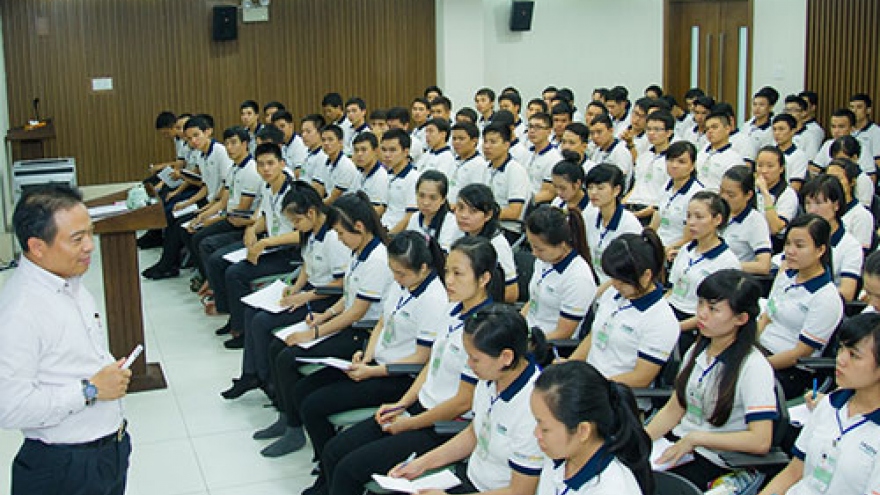Employers fill gap in workforce training
As foreign companies continue to face a shortage of skilled employees, redressing the issue of practical education and training has become a pressing concern for the country as well as for many big investors here.
 |
The Republic of Korea (RoK)’s LG Display is planning to launch its new US$1.5 billion facility in the northern port city of Haiphong in early 2017, however, first the company must source enough skilled workers to run the facility.
Beginning construction a month ago, the facility, which will produce new-generation OLED screens, expects to employ as many as 6,000 local employees.
The employees will be in charge of many activities, such as research and development (R&D), supervision, and quality control.
However, all of them would need training programs that will last from one month to four months, and even several years (for R&D-focused employees), before they can officially work at the factory. Notably, the training programs will be organized by LG Display itself, as the workers cannot otherwise meet standards set by the firm.
In another case, Samsung employs about 110,000 workers in Vietnam at present, with the vast majority in its two manufacturing complexes in the northern provinces of Bac Ninh and Thai Nguyen. Once the company’s new US$1.4 billion consumer electronics complex becomes operational in Ho Chi Minh City, Samsung will need to hire an additional 5,000 employees.
To address its demand for skilled workers, Samsung has signed agreements with several universities and its workers have to attend training courses within the complexes. Here, they can study English and Korean, as well as accountancy and electronic engineering.
Samsung is cooperating with Hanoi University of Industry (HUI) and Hanoi University of Science and Technology (HUST) to train skilled engineers and conduct studies and research.
The company has recently inaugurated its Samsung Lab at HUI. The lab’s main remit is to boost study and research activities among students and lecturers at HUI.
HUI has also been cooperating with many foreign firms in Vietnam such as Taiwan (China)’s Foxconn Technology Group at the Hon Hai Technology Training Centre within the university. The centre’s fulltime courses have benefited thousands of students, many of whom now work at Foxconn’s Bac Ninh factory.
Meanwhile, HUST is raising its cooperation with nearly 40 Asian firms in Vietnam, including major players Toyota, Lotte, Nippon, Toshiba, Compal, Dasan, Posco, and LG. Many students from this university have secured full-time positions at these firms.
In addition to cooperating with three Australian firms, HUST is also collaborating with 14 American firms across a series of training programs, including Intel, IBM, American Technologies, and Cadence Design Systems.
An additional 14 European firms like ABB, Siemens, Orange France Telecom, and Festo are involved in these training initiatives.
Quach Thi Nhung, head of Human Resources with the RoK’s garment maker KJ Vina, told VIR that the company had to re-train many of the 1,600 workers in the Binh Duong facility.
“The training courses often take place over the course of a month, before new workers can officially begin work at the factory,” Nhung said.
Eric Yeo, IBM Vietnam’s country general manager, told VIR that if Vietnam wanted to move up in the global value chain, it must improve its training and education quality and boost technological renovation across the board.
“As Vietnam wants to move towards higher added value, technical-intensive industries, and service sectors, it needs to equip its workforce with the necessary skills for this changing environment,” Yeo said.
Commenting on Vietnam’s educational and training quality, the World Bank’s recent report “Skilling up Vietnam: Preparing the workforce for a modern market economy” noted that “a skilled workforce is central to Vietnam’s economic modernization.”
“Employers in Vietnam struggle to find the right workers. Despite impressive literacy and numeracy achievements among Vietnamese workers, many firms report a shortage of workers with adequate skills as a significant obstacle to their activities,” the report stressed.
A World Bank survey of the operation of foreign firms in Vietnam shows that about 63% of international firms view the lack of labour with the right skills as an obstacle to their activities, and nearly half of these firms view it as a major obstacle.
Nearly 40% of international firms see the general education of workers as an obstacle, and 46% see vocational education as an obstacle. Employers from international firms estimated that 14% of their employees were not fully qualified to do their jobs.


